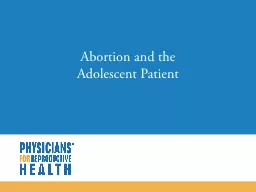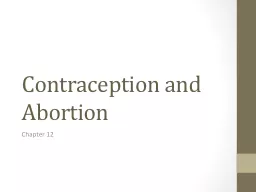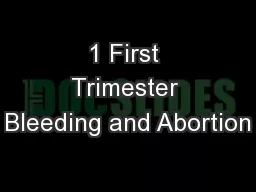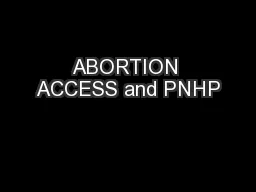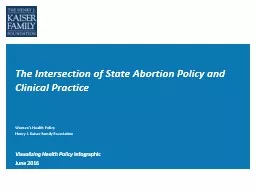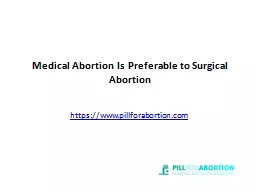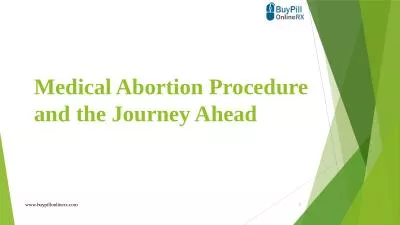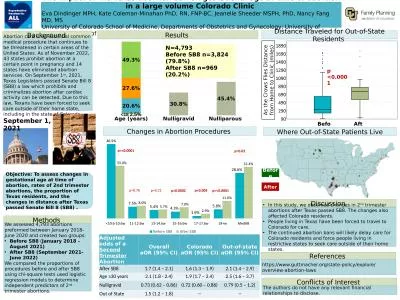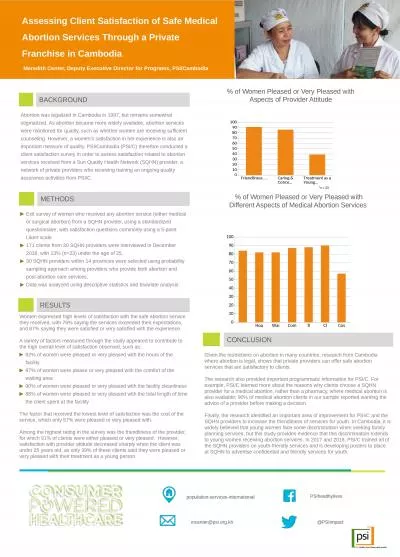PPT-Abortion and the Adolescent Patient
Author : natalia-silvester | Published Date : 2018-12-07
Objectives Offer support and appropriate referrals to your adolescent patient who has decided to have an abortion Describe both medication and aspiration methods
Presentation Embed Code
Download Presentation
Download Presentation The PPT/PDF document "Abortion and the Adolescent Patient" is the property of its rightful owner. Permission is granted to download and print the materials on this website for personal, non-commercial use only, and to display it on your personal computer provided you do not modify the materials and that you retain all copyright notices contained in the materials. By downloading content from our website, you accept the terms of this agreement.
Abortion and the Adolescent Patient: Transcript
Objectives Offer support and appropriate referrals to your adolescent patient who has decided to have an abortion Describe both medication and aspiration methods and review current literature on adolescents and abortion . Twentyone percent of all pregnancies excluding miscarriages end in abortion In 2011 106 million abortions were performed down 13 from 121 million in 2008 From 1973 through 2011 nearly 53 million legal abortions occurred Each year 17 of women aged Dr Anibal Faundes. 12th National Turkish Gynaecology and Obstetrics Congress" . Antalya, 15-19 May 2014. Induced abortions. can be. . legal and safe. . . Induced abortions. can be. Chapter 12. Learning Objectives. Contraception. Contraception in the US: The political battle. Methods of Contraception. Abortion. Perspectives on Abortion. Methods of Abortion. Contraception. Contraception in US: The Legal Battle. MS-3 Case Based Series. Gretchen S. Stuart, MD, MPHTM. Amy G. Bryant, MD. Jennifer H. Tang, MD. Family Planning Program, Department of Obstetrics and Gynecology. UNC-Chapel Hill. Updated November 1, 2010 . Linda Prine MD. Kelita Fox MD. Erin Hendriks MD. Linda Prine MD. The Recent Supreme Court. (From Left) Fatimah Gifford, Amy . Hagstrom. Miller, Andrea . Ferrigno. , of Whole Woman’s Health on the Steps of the Supreme Court. Women’s Health Policy. Henry J. Kaiser Family Foundation . Visualizing Health Policy . Infographic. October . 2016. NOTES: Data are from 38 reporting areas in 2012. Excludes 14 areas: CA, CT, D.C., FL, IL, ME, MD, MA, NE, NH, NY, PA, WI, & WY. Percentages may not add up to 100% due to rounding. . 103Abbreviated nameObstetric and gynaecological admissions owing to abortionIndicator nameObstetric and gynaecological admissions owing to abortionDomainHealth systemsSubdomainHealth system strengthen Individuals will generally avoid medical operations, even simple ones, and regard them as a long course for any therapy. https://www.pillforabortion.com Debre. . Markos. town health institutions , . Amhara. Regional State, Ethiopia.. By: Tewodros . Seyoum. (Ass.Prof of midwifery, PhD fellow). . 1 icine Mana g e ment a nd R e fer r a l G Provided by Adolescent Medicine Pediatric/Adolescent Gynecology 7 Adolescent Med icine Manament nd uidelines Menstrual IrregularityMenstrual disturb Are you considering an abortion but don\'t know where to start? This guide will teach you everything you need to know about terminating your pregnancy with misoprostol pills. A safe and efficient method of ending a pregnancy is a medical abortion. Find out more about the process, including what to anticipate both during and after it. Discover useful advice for controlling your mental, emotional, and physical health as you recover. Eva Dindinger MPH, Kate Coleman-Minahan PhD, RN, FNP-BC, Jeanelle Sheeder MSPH, PhD, Nancy Fang MD, MS. University of Colorado School of Medicine, Departments of Obstetrics and Gynecology; University of Colorado College of Nursing . BACKGROUND. Exit survey of women who received any abortion service (either medical or surgical abortion) from a SQHN provider, using a standardized questionnaire, with satisfaction questions commonly using a 5-point Likert scale..
Download Rules Of Document
"Abortion and the Adolescent Patient"The content belongs to its owner. You may download and print it for personal use, without modification, and keep all copyright notices. By downloading, you agree to these terms.
Related Documents

